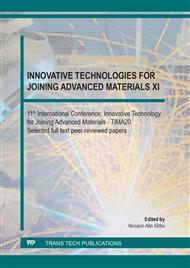[1]
Octavian Oanca, Nicușor-Alin SÎRBU, Hybrid process for joining - electrical by pressure and with ultrasounds, BID, 3/2007, pg. 27-35.
Google Scholar
[2]
A.-V. Bîrdeanu, C. Ciucă, A. Puicea, Pulsed LASER-(micro)TIG hybrid welding: Process characteristics,, Journal of Materials Processing Technology, vol. 212(4), pg. 890-902.
DOI: 10.1016/j.jmatprotec.2011.11.014
Google Scholar
[3]
R. Cojocaru, C. Ciucă, L. Boţilă, V. Verbiţchi, FSW – TIG Welding of Cu 99 Copper, Welding and Material Testing, 1/2015, ISSN 1453-0392.
Google Scholar
[4]
X. C. Liu, C.S. Wu - Material flow in ultrasonic vibration enhanced friction stir welding, Shandong University, Chi-nan-shih, Shandong Sheng, China, Journal of Materials Processing Technology, 11/2015; 225.
DOI: 10.1016/j.jmatprotec.2015.05.020
Google Scholar
[5]
G. K. Padhy, C. S. Wu, S. Gao - Auxiliary energy assisted friction stir welding – Status review, Science and Technology of Welding & Joining 06/(2015).
DOI: 10.1179/1362171815y.0000000048
Google Scholar
[6]
X. C. Liu, C.S. Wu - Elimination of tunnel defect in ultrasonic vibration enhanced friction stir welding, Shandong University, Chi-nan-shih, Shandong Sheng, China.
Google Scholar
[7]
D. Dehelean, Octavian Oanca, Cr. Toma, Corneliu Craciunescu, Advanced materials joining using a hybrid ultrasonicelectric resistance technique, September 2010, Journal of Optoelectronics and Advanced Materials 12(9), pg. 1935-1941.
Google Scholar
[8]
Marius Adrian Constantin, Ana Bosneag, Eduard Laurenţiu Niţu, Lia Nicoleta Botila, Establishing the Dependence of Output Parameters Depending on Local Process Conditions for Friction Stir Welding of Pure Copper Plates, Advanced Materials Research, 2018 Trans Tech Publications, Switzerland, ISSN: 1662-8985, Vol. 1146, pg 32-37.
DOI: 10.4028/www.scientific.net/amr.1146.32
Google Scholar
[9]
Thomas, W, sa – Improvements relating to friction welding, European Patent Specification, 0 615 480 B1.
Google Scholar
[10]
E.Hoyos, D.López, H.Alvarez, A phenomenologically based material flow model for friction stir welding, Elsevier, Materials & Design, Volume 111, 5 December 2016, Pg 321-330.
DOI: 10.1016/j.matdes.2016.09.009
Google Scholar
[11]
Leonard, AJ și SA Lockyer, Defecte la sudurile prin frecare, 14 mai 2003 Park City, SUA: TWI, V 1-10, (2003).
Google Scholar
[12]
Jene, T., et al., Monitorizarea procesului de sudare prin frecare pentru a descrie efectele parametrilor asupra calității îmbinării,, TWI, (2007).
Google Scholar
[13]
Lai Ruilin, He Diqiu, Liu Luocheng, Ye Shaoyong and Yang Kunyu, (2011), Ultrasonound-assisted friction stir welding, Patent Application Publication US 2011/0151275 A1, Jun. 23, 2011, United States.
DOI: 10.1007/s00170-014-5813-8
Google Scholar
[14]
Gerd Dobmann, Dietmar Eifler, Tobias Jene, Guntram Wagner, (2014), A study of the temperature field during ultrasonic-assisted friction-stir welding, Int J Adv Manuf. Technol. (2014) 73:321–327, DOI 10.1007/s00170-014-5813-8.
DOI: 10.1007/s00170-014-5813-8
Google Scholar
[15]
Wolfram Fuerbeth-Realization of Al/Mg-Hybrid-Joints by Ultrasound Supported Friction Stir Welding - Mechanical Properties, Microstructure and Corrosion Behavior, Advanced Materials Research 06/2014; 966-967:521-535.
DOI: 10.4028/www.scientific.net/amr.966-967.521
Google Scholar
[16]
Kwanghyun Park - Numerical simulation of plunge force during the plunge phase of friction stir welding and ultrasonic assisted FSW Department of Mechanical Engineering, University of Michigan Ann Arbor, MI 48109 USA.
DOI: 10.1115/imece2008-67002
Google Scholar
[17]
http://www. nsf.gov/eng/iucrc/directory/csfp/jsp.
Google Scholar
[18]
Henneböhle,U – FSW Basic principles and recent trends, Schweissen und Schneiden 2005, DVS Verlag Düsseldorf, (2005).
Google Scholar


